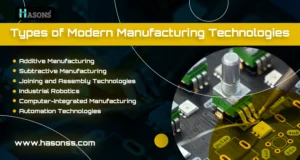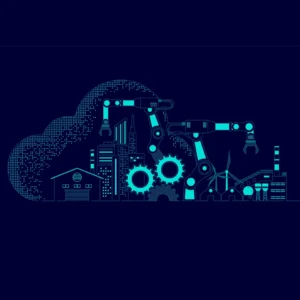Manufacturing Technology
Manufacturing has been core to human civilization for thousands of years. From the earliest stone tools to modern high-tech factories, we’ve constantly sought new ways to make production faster, cheaper, and higher quality. Today, manufacturing accounts for 16% of global GDP and employs over 200 million people worldwide.
A Brief History of Manufacturing Technology
Humans have been “manufacturing” goods since prehistoric times. Early hunter-gatherers crafted stone axes, arrows, pottery, and clothing using hand tools and basic processes. Manufacturing began advancing faster during the First Industrial Revolution starting in the 1700s.
Key Developments of the Industrial Revolutions
The First Industrial Revolution introduced mechanization and steam power. New machines like the spinning jenny and steam engine enabled mass production in textiles and other industries.
In the Second Industrial Revolution during the late 1800s and early 1900s, breakthroughs in electricity, the combustion engine, and assembly lines led to mass production. Iconic examples like Henry Ford’s Model T cars highlight this shift.
Modern Manufacturing Process Evolution
Alongside these sweeping industrial revolutions, Manufacturing processes themselves rapidly evolved too. Traditional techniques like milling, casting, forming, welding, and mechanical joining remain essential parts of any factory.
Mass production methods like interchangeable parts and the assembly line also carry on. Lean manufacturing techniques that optimize workflows and reduce waste have emerged more recently.
Types of Modern Manufacturing Technologies
Today’s factories utilize a variety of technologies working together. Each has its strengths and applications. The main categories include:

Additive Manufacturing
Also known as 3D printing, additive manufacturing builds objects layer-by-layer from materials like metals, polymers, and composites. It’s best for rapid prototyping, custom items, and complex geometries.
Popular techniques include material extrusion (FDM), vat photopolymerization (SLA), powder bed fusion (SLS), directed energy deposition, sheet lamination, and binder jetting. Aerospace, dental, medical, and automotive industries use additive most.
Subtractive Manufacturing
Subtractive manufacturing cuts, drills, or grinds material away from a solid block to form a part. CNC machining centers and lathes are the most common tools. The automotive, aerospace, energy, and electronics industries rely on subtractive techniques to produce metal components and parts.
Forming, Casting, and Molding Processes
Metal forming produces components by deforming raw material using dies and presses. Common techniques include forging, rolling, extrusion, stamping, and bending. Casting pours molten metal into a mold cavity to make parts. Die casting and sand casting are frequently used.
Molding is essential for plastics and polymers. Injection molding, compression molding, rotational molding, and blow molding shape these materials in high volumes.
Modern innovations like laser welding, adhesive bonding, and automated assembly improve quality and throughput. Joining and assembly technologies create complex, multi-part products from simpler components.
Industrial Robotics
Robots excell at repetitive, dangerous, and high-precision tasks on the factory floor. Robotic arms can handle assembly, pick-and-place, dispensing, welding, painting, palletizing, product inspection, and more. Robotic capabilities keep advancing with sensors, computer vision, AI, and collaborative designs.
Computer-Integrated Manufacturing
Modern computer-integrated manufacturing (CIM) connects engineering, production, inventory, quality control, and management together. CIM lets factories coordinate customer orders, design specs, production scheduling, inventory levels, and logistics seamlessly thanks to IT networks.
Automation Technologies
Programmable automation gives operators precise control over equipment and processes. PLCs, PACs, HMIs, and industrial PCs run automated workflows while collecting critical performance data.
This wide spectrum of manufacturing technologies empowers limitless applications. Next, let’s look at the core benefits these innovations provide.
The Value of Modern Manufacturing Innovations
From hand tools to fully automated smart factories, manufacturing technology pursues several key goals:
Improved Productivity and Efficiency
Machines and automation work faster, more precisely, and around the clock to dramatically increase manufacturing productivity. With less human effort required, costs decline as throughput rises.
Higher Quality and Consistency
Precision automation and monitoring ensure each product meets specifications. Defects and variations are eliminated, while quality control is engrained at every step.
Flexibility and Responsiveness
Reconfigurable work cells, CIM systems, and digital management tools allow smart factories to quickly adapt. Custom and small-batch orders can be fulfilled efficiently alongside mass production.
Waste and Emission Reduction
Optimizing processes, reusing materials, and monitoring energy usage cuts resource waste. Manufacturing sustainability improves through better technology.
Safer Working Conditions
Automating hazardous tasks protects factory workers from injury. Production robots also reduce heavy lifting and repetitive work that can harm long-term health.
Product and Process Innovation
Emerging technologies open new possibilities for product designs, materials, and production techniques before unfeasible. Better manufacturing drives innovation across every industry.
Next, we’ll do a deep dive into one of today’s most transformative and exciting manufacturing innovations.
How Additive Manufacturing is Revolutionizing Production
Also called 3D printing, additive manufacturing builds up parts layer-by-layer from metals, polymers, ceramics, and specialty materials. First invented in the 1980s, it initially focused on prototyping. Today, additive is driving sweeping changes on the factory floor.
Advantages Over Traditional Techniques
Additive manufacturing has several major strengths compared to subtractive machining and other conventional methods:
- Design Freedom – Intricate shapes, optimized lattices, and complex geometries are printable. No tooling restricts part designs.
- Customization – Adjustments and unique features can be added without added costs. Small batch sizes down to one-offs are affordable.
These advantages make additive ideal for industries like aerospace, medical, dental, automotive, and anywhere requiring lightweight, complex components. However, challenges remain before additive manufacturing can go fully mainstream.
Current Challenges Holding Additive Back
Additive has made huge progress, but limitations persist:
- Speed – Additive systems remain far slower than mass production methods like injection molding. Build times for large parts can be days.
- Material Options – Far fewer materials are available compared to conventional processes. Most common are polymers and metals. Ceramics and composites are emerging.
Additive has come far quickly, but becoming a peer to other high-volume processes will take further development. Nevertheless, the technology holds immense potential.
The Future of Additive Manufacturing
Additive manufacturing is projected for continued exponential growth in coming decades. According to one forecast, the industry will expand from $13 billion in 2021 to over $130 billion by 2030.
- Faster Printers – New systems cut production times drastically, making short-run mass customization feasible. Hybrid CNC may combine additive with subtractive.
- Advanced Materials – New printable metals, composites, and ceramics will expand additive into more applications demanding high performance.
Additive is on track to become a foundational component of smart factories thanks to progress in these areas. Manufacturers need to begin experimenting now to plan for additive’s advantages.
Glimpsing the Future: Manufacturing in the Fourth Industrial Revolution

The ongoing Fourth Industrial Revolution centered on interconnected cyber-physical technologies will profoundly reshape manufacturing in coming decades. Here are some of the key developments on the horizontal.
Manufacturing is undergoing a digital transformation. Organizations need strategic roadmaps leveraging these emerging technologies or risk falling behind competitors.
Real-World Manufacturing Technology Examples
These manufacturing innovations enable products and capabilities that enhance our world daily:
- Additive Manufacturing of Aircraft Parts – GE and Boeing now use 3D printing to produce lightweight aircraft engine and structural components. Additive techniques enable more complex geometries and consolidation of multipart assemblies.
- Humanoid Robot Arms – Advanced robots like the FANUC M-2000iA excel at handling delicate parts for injection molding automation.
Key Manufacturing Skills Moving Forward
To leverage emerging technologies and remain competitive, manufacturing professionals should focus on building these skills:
- Programming – Understanding code is mandatory for working with automated systems, robots, additive printers, and digital manufacturing software. Languages like Python also enable data analysis.
- Data Science – Manufacturing produces vast data flows. Analyzing this big data demands statistical modeling, machine learning, and analytics skills to uncover hidden efficiencies..
By developing this diverse skillset combining the physical and digital, tomorrow’s workforce will thrive through the next industrial revolutions.
| If you are Reading Manufacturing Technology, then also check our other blogs: | |
| Network Monitoring | Types of Technology |
| Identity Management | Ethical Hacking |
